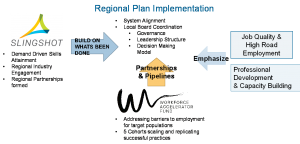Regional Organizing
Regional Organizing: Plan Implementation and Professional Development

The California Workforce Development Board’s “State Plan” encourages collaboration between workforce and educational programs at the regional level in order to align programs with each other and regional labor market dynamics. The objective of regional organizing efforts is not to create monolithic one-size-fits-all uniform workforce and education program, but rather to organize resources, effective approaches, systems and leadership to achieve scale and impact, and coordinate service delivery on the basis of programs strengths while also aligning partner programs with each region’s particular labor market needs. The exact manner in which these partnerships come together varies from region to region based on the unique set of circumstances that shape each region’s workforce needs.
The Governor has designated 14 regional planning units (RPU’s) that are aligned with regional labor markets to facilitate the development of regional plans that implement sector strategies, coordinate service delivery, pool administrative costs, and develop shared strategies among regionally organized Local Boards to ensure accountability and overall program performance. The State’s investment in the development and implementation of regional plans include:
1. Regional Organizing to build momentum and strengthen regional leadership by identifying and enhancing partnerships of leaders in the system who value regional collaboration, strategically maintaining ongoing efforts to accomplish regional plans goals, and enhancing communication between regions and the state. Regional Organizers are hired by the local Workforce Development Boards in each region and are charged with supporting ongoing efforts to enhance regional workforce leadership collaboration and implement the Regional Plans. They:
- Act as the liaison between the State Board and regional leaders and the communication pipeline between the State Board and LWDB Directors.
- Encourage alignment of workforce development, education and economic development in efforts to engage employer/industry champions and promote services to individuals with barriers to employment by supporting ongoing dialogue between labor, business, education, community, and the public workforce system
- Support LWDB Directors in connecting State Board members and Technical Assistance (TA) providers with regional partners to assist in implementation opportunities, barriers and challenges, including identifying and overcoming policy obstacles.
- Support implementation of their region‘s Regional Plan
- Identify promising practices and successful convening efforts that link policy and practice.
- Identify related and relevant state and federal grant projects that should be aligned/coordinated with the regional effort.
- Work with regional coalitions, CWA, and State Board to build capacity of local board staff and partners.
2. Building Capacity of Staff and Partners by developing infrastructure for ongoing training and capacity building and implementing professional development, capacity building and cross training initiatives for Local Boards, America’s Job Centers of California, and State Plan partners. Efforts coordinated by:
- Statewide Training Coordinator: California Workforce Association (CWA) responsible for surveying local Workforce Development Boards and core to identify training priorities and develop statewide capacity building plan
- Regional Training Coordinators: A training coordinator from each of the 14 Regional Planning Units works with CWA, EDD, and the State Board to identify training priorities and schedule training for Local Boards, Core Partners and AJCC staff.
- California Training Institute Training Fund: An approved vendor list of Consultants/Trainers has been established by CWA and funded by the State Board to meet regional and statewide training needs, provide technical assistance requested by local or regional Workforce Development Boards, or assist with Peer-to-peer technical assistance
To view the Regional Implementation page click here.
